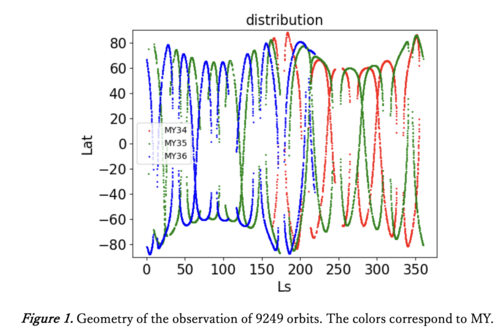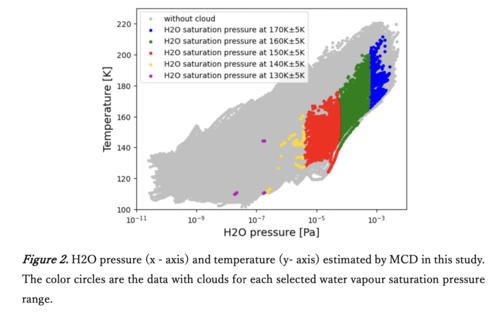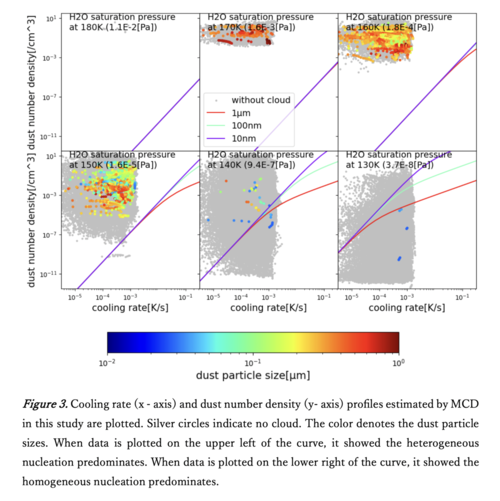- 1Graduate School of Science, Tohoku University, Sendai, Japan (kaito.koizumi.p3@dc.tohoku.ac.jp, hiromu.nakagawa.c1@tohoku.ac.jp, kktanaka@astr.tohoku.ac.jp, teradan@tohoku.ac.jp, kasaba.y@tohoku.ac.jp)
- 2Faculty of Science and Technology, Seikei University, Musashino, Japan (h_fujiwara@st.seikei.ac.jp)
- 3Department of Computer and Network Engineering, University of Electro-Communications, Chofu, Japan (takuo.tsuda@uec.ac.jp)
- 4Institute of Low Temperature Science, Hokkaido University, Sapporo, Japan (ykimura@lowtem.hokudai.ac.jp)
- 5Graduate School of Frontier Sciences, The University of Tokyo, Kashiwa, Japan (shohei.aoki@edu.k.u-tokyo.ac.jp)
- 6Royal Belgian Institute for Space Aeronomy (BIRA-IASB), Brussels, Belgium (a-c.Vandaele@aeronomie.be, ian.thomas@aeronomie.be, bojan.ristic@aeronomie.be, frank.daerden@aeronomie.be, zachary.flimon@aeronomie.be, yannick.willame@aeronomie.be)
- 7School of Physical Sciences, The Open University, Milton Keynes, UK (jon.mason@open.ac.uk, manish.patel@open.ac.uk)
- 8School of Engineering, University of Basilicata, Potenza, Italy (giuliano.liuzzi@unibas.it)
- 9Istituto di Astrofisica e Planetologia Spaziali (IAPS), Istituto Nazionale di Astrofisica (INAF), Rome, Italy (giancarlo.bellucci@inaf.it)
- 10Instituto de Astrofísica de Andalucía (IAA), Consejo Superior de Investigaciones Científicas (CSIC), Granada, Spain (lopez@iaa.es)
In the mesosphere on Earth, water ice clouds are frequently observed in the low-temperature region (below -130℃) at altitudes 80-90 km in the polar region. Two mechanisms have been proposed to explain the formation of these ice particles. One is homogeneous nucleation, in which condensation nuclei are formed from water vapour. The other is heterogeneous nucleation, in which substrates such as aerosol in the atmosphere undergo a phase change as nuclei. The latest theoretical study shows that heterogeneous nucleation is predominant in the nucleation of mesospheric clouds on Earth and that homogeneous nucleation is unlikely to occur, when compared to observed conditions (Tanaka et al., 2022; https://doi.org/10.5194/acp-22-5639-2022). This theory may apply to cloud formation in other planetary atmospheres. On Mars, mesospheric clouds like those on Earth have been observed, but there are still many unresolved issues. In particular, the nucleation has only been studied theoretically by applying a classical theory for the lower atmospheric clouds (Määttänen et al., 2005). The purpose of this study is to clarify the nucleation mechanism of the Martian mesospheric clouds by comparing the mesospheric cloud observations obtained at Mars with theory of Tanaka et al. (2022).
We used the solar occultation spectral data obtained by the ultraviolet (UV) to visible (VIS) channel UVIS of the Nadir and Occultation for MArs Discovery (NOMAD) spectrometer on board the ExoMars Trace Gas Orbiter (TGO) to clarify the purpose. The observational data considered this study consist in 9249 atmospheric transmission profiles covering the period from Ls (areocentric longitude of the sun) = 163°in MY (Martian Year) 34 to Ls = 218°in MY 36 (2018/4/22-2022/4/30) (Figure 1). In this study, we derive the total optical depth along the line of sight (slant opacity) from the transmittance spectra (Streeter et al., 2021). We attempt to distinguish between water ice clouds and dust by comparing the slant opacity at 320 nm, where we assume a large contribution from water ice clouds, with the slant opacity of all aerosols, including dust, at 600 nm. The existence of water ice clouds is determined under the conditions that the optical thickness at 320 nm is larger than 0.01 at altitudes of 40-100 km and the slant opacity ratio (320 nm / 600 nm) is larger than 1.5. The atmospheric density, dust density, atmospheric temperature and cooling rate, dust particle size, and water vapour pressure of the atmospheric conditions are estimated from the Mars Climate Database (MCD) (version 5.3; Millour et al., 2012), a numerical atmospheric general circulation model, and applied to the theory of Tanaka et al. (2022) to investigate the possibility of homogeneous and heterogeneous nucleation.

Following the thresholds described above, Martian mesospheric water ice clouds were detected in 966 out of 9249 altitude distributions (152 in MY 34, 615 in MY 35, and 199 in MY 36). In addition, the relationship between clouds and the background atmospheric field was investigated, and it was clear that clouds tend to form under atmospheric conditions where the water vapor pressure is above 10-5 Pa and the temperature is below 200 K (Figure 2). Out of the 966 data, data were selected by saturated vapour pressure corresponding to every 10 K in the range of 130 K to 180 K. These were compared with the conditions obtained by Tanaka et al. (2022) for whether homogeneous or heterogenous nucleation predominates (Figure 3). The results suggested that when the background atmospheric water vapour pressure is above 1.56-5 Pa (saturated water vapour pressure at 150 K) at the time of cloud formation, the Martian atmosphere can only have atmospheric conditions where heterogeneous nucleation occurs, as on Earth. This result clarified that heterogeneous nucleation is predominant in the nucleation of mesospheric water ice clouds on Mars. On the other hand, when the water vapour pressure is less than 9.40-7 Pa (saturated water vapour pressure at 140 K), it was indicated that the Martian atmosphere can have atmospheric conditions that produce homogeneous nucleation. In fact, some of the clouds detected at altitudes above 70 km below the saturated water vapour pressure of 140 K suggested the possibilities of homogeneous nucleation. The latter is unexpected because it is a Mars-specific event that cannot occur on Earth. Detailed analysis of the dust density and dust particle size using the results derived from the instrument's observation data is needed in the future, to clarify the atmospheric conditions under which homogeneous nucleation can occur, which is not seen on Earth but is suggested on Mars.


How to cite: Koizumi, K., Nakagawa, H., K. Tanaka, K., Fijiwara, H., Tsuda, T., Kimura, Y., Aoki, S., Terada, N., Kasaba, Y., Vandaele, A. C., Thomas, I., Ristic, B., Daerden, F., Flimon, Z., Willame, Y., P. Mason, J., R. Patel, M., Liuzzi, G., Bellucci, G., and López-Moreno, J. J.: Nucleation mechanism of mesospheric water ice clouds on Mars observed by TGO/NOMAD, Europlanet Science Congress 2024, Berlin, Germany, 8–13 Sep 2024, EPSC2024-718, https://doi.org/10.5194/epsc2024-718, 2024.